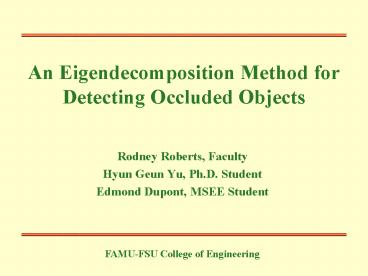An Eigendecomposition Method for Detecting Occluded Objects - PowerPoint PPT Presentation
1 / 20
Title:
An Eigendecomposition Method for Detecting Occluded Objects
Description:
... to deal with occlusion and background clutter. FAMU-FSU College of Engineering ... Eigenspace image comparison: evaluate candidate locations to simultaneously ... – PowerPoint PPT presentation
Number of Views:38
Avg rating:3.0/5.0
Title: An Eigendecomposition Method for Detecting Occluded Objects
1
An Eigendecomposition Method for Detecting
Occluded Objects
- Rodney Roberts, Faculty
- Hyun Geun Yu, Ph.D. Student
- Edmond Dupont, MSEE Student
2
Eigenspace Methods
- also known as
- Principal Component Analysis (PCA)
- Singular Value Decomposition (SVD)
- Karhunen-Loeve transformation
- applications
- image compression
- human face recognition
- object/pose recognition
3
Eigenspace Methods
- advantages
- appearance based (no model)
- relatively fast on-line calculation
- disadvantages
- slow off-line computation
- difficult to deal with occlusion and background
clutter
4
Example
- Training Images
5
Subspace Representation
- Eigenimages
- Reconstructed Images
6
SVD-Based Object/Pose Detection - No Occlusion
Original Images Normalize Size Normalize
Intensity Average Image
7
SVD-Based Object/Pose Detection - No Occlusion
Average subtracted Eigenimages
8
SVD-Based Object/Pose Detection - No Occlusion
Projection onto Eigenspace
9
Problems when occlusion is present
- Segmentation becomes difficult
- Scale normalization cannot be done
- Intensity normalization will not work
- Projection onto the eigenspace will be affected
10
Proposed method
- Approach
- Localization generate candidate locations
- Eigenspace image comparison evaluate candidate
locations to simultaneously register the object
and identify its pose - Differences
- based purely on appearance
- uses a quad-tree data structure
- Scenarios
- occlusion
- background clutter
11
Quad-tree structure
12
Quad-tree eigenspace image comparison -Level 1
13
Quad-tree eigenspace image comparison - Level 2
14
Quad-tree eigenspace image comparison -Level 3
15
Conclusions
- algorithm using localization and quad-tree
eigen-decomposition is effective for dealing with
occlusion - accuracy is proportional to the difficulty of the
problem - computational expense is proportional to the
difficulty of the problem - much more computationally expensive than
unoccluded objects in controlled environments
16
Vegetation Classification
classified image
u1 vs u2
17
20-meter Accuracy
u1
classified image
18
80-meter Accuracy
classified image
u1
19
Singular Vector Comparison
80 meters
20 meters
20
Singular Vector Comparison
refined 80 meters
20 meters































